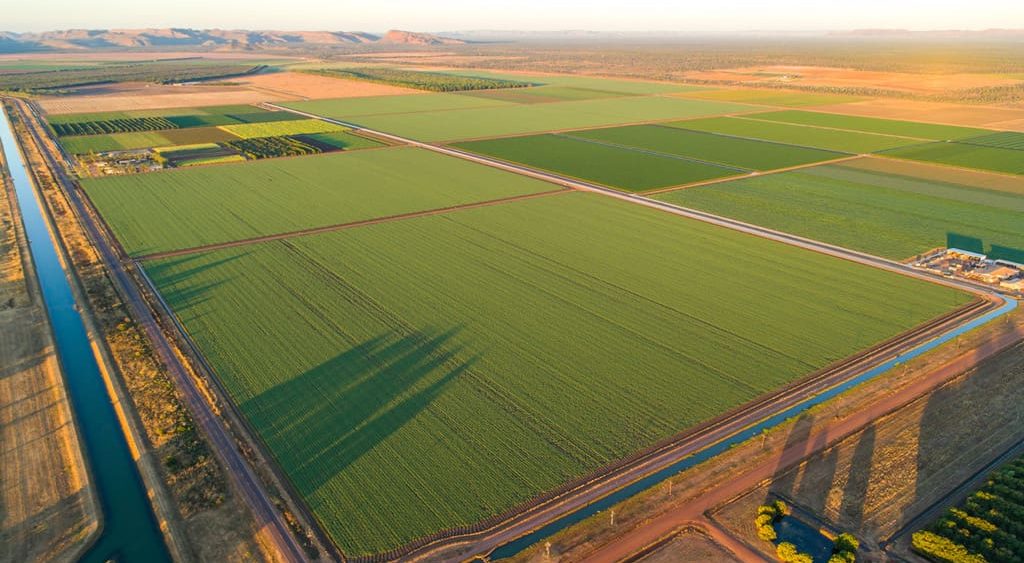
Irrigated cropping in the Ord region of WA. Photo: Ord Irrigation Cooperative
THE EXPANSION of irrigated cropping in the Ord has reached a milestone with the formalisation of a development lease agreement for the cultivation of the Knox farmlands east of Kununurra.
The 5400ha lease agreement granted to Kimberley Agricultural Investment by the Western Australian Government marks another step forward for the cotton and cropping industry since the original 2014 Ord Development Agreement.
KAI is partnering with Keep Farming, a company owned by northern Australian cropping pioneer and former large-scale New South Wales grain and cotton grower Ron Greentree to develop the land.
WA Lands Minister John Carey said this was a “significant agreement” that would “support new farmland development and long-term crop production for Knox Plain”.
“This agreement paves the way for the leaseholders to sustainably develop these fertile black-soil plains, create jobs and provide social and economic benefits for the region and the Miriuwung Gajerrong people,” Mr Carey said in a statement.
KAI general manager Jim Engelke said the lease agreement formalised the development of Knox Plains.
He said the company had been farming there for about three years under interim agreements.
“It is good news that we formally have the development lease,” Mr Engelke said.
“We are looking into the future and trying to set ourselves up for a newly established cotton industry and continuing the maize and hay and other things that exist in the region.”
Initial land clearing at Knox Creek Plain commenced in 2020 but stopped later that year due to the discovery of a rare plant species.
Further development recommenced in 2022.
Mr Engelke said the land has been cleared and channels prepared with the aim of planting a crop on the site next year.
In late 2022, the WA Government allocated $77.1 million for vital water infrastructure upgrades in the Ord to support required water volumes to Knox and drive agricultural expansion in the area.
The works will be delivered by the Water Corporation, with ramping up of water supply to full delivery requirement for Knox of 570 megalitres per day by 2027.
The project will expand on KAI’s long-term development of a 7400ha parcel at Goomig or Weaber Plains, located about 30km north of Kununurra.
KAI harvested its first crop at the site in 2015, cultivating a variety of irrigated grains, pulses and seeds, mostly maize and cotton.
The company also manages a cropping program at the 476,000ha Carlton Hill Station, north of Kununurra, which it has owned since 2016.
Former station owner Consolidated Pastoral Company leases most of the country, with KAI earmarking 14,000ha for irrigated cropping.
Stage 1 of the Carlton Hill development, which included works across 3055ha of land, was approved by the WA Government in 2018.
Cotton gin on track
In another step forward for the cotton industry in the Ord, Mr Engelke said construction on the region’s first gin was on track to be completed by the second half of 2025, despite recent heavy rain.
Construction commenced on the $60M Kununurra facility in June last year.
“It is under construction, we’re on time and so far, we are holding our timelines.
“A cotton gin operating in Kununurra next year…will see an expansion of cotton production in this part of the world quite significantly to feed that cotton gin.”
Namoi Cotton is constructing the facility on behalf of gin owner Kimberley Cotton Company.
Namoi Cotton is also a key shareholder of KCC, alongside KAI, Prime Grain, MG Corporation, and the Ord River District Co-operative.
Wet hinders planting
The Ord’s growers had a disjointed start to the cotton season, with extended periods of wet weather limiting planting opportunities.
It is estimated that the rainfall during the planting window – which closed on March 28 – has cut cotton hectares about 15-20pc on last season.
Mr Engelke said KAI planted some cotton this season as well as a decent maize area.
“It has been a very wet, wet season and we haven’t had a lot of on-farm activity in a while.”
Cotton Grower Services agronomist based at Kununurra Tommy Palmer said there was marked variation in crop growth across soil types.
“It’s been a start, stop, start, stop process for a long time since the window opened on 1st of February.
“The cotton stages are variable and there is a big difference between the cotton that is planted on the sandier soil and the heavier black soil.”
She said crops planted in black soil had suffered some water-logging, while plants in better-draining, lighter soils were “powering away”.
Ms Palmer said growers would be hoping for decent stretches of sunshine to dry the ground and promote plant growth.
“It looks like there is going to be showers and storms for the next week then we will be in the clear.
She said the industry was still learning how to navigate planting in the Ord and different rates of crop growth in varying wet seasons.
“There is still a lot more research to do; there is still a lot more trials and things we need to tweak.”
Grain Central: Get our free news straight to your inbox – Click here

HAVE YOUR SAY